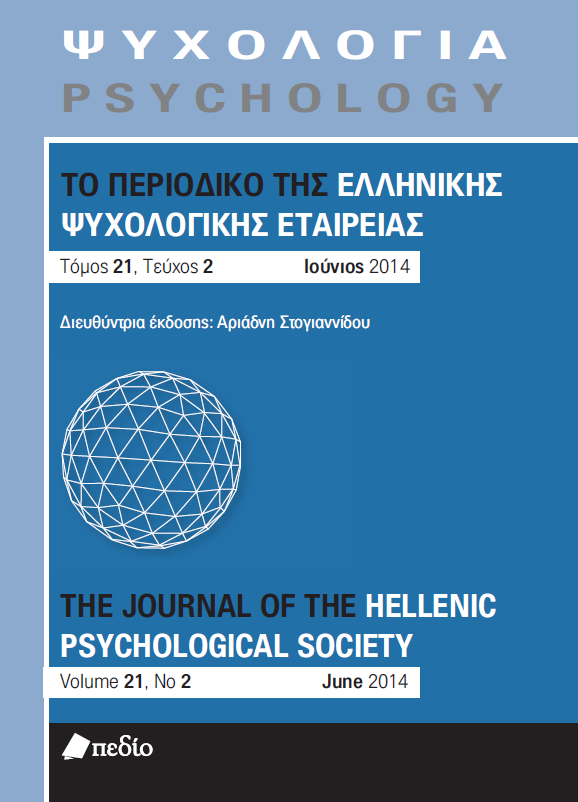Στάσεις και στιγματισμός σχετικά με την αναζήτηση ψυχολογικής βοήθειας: το παράδειγμα του στρατιωτικού περιβάλλοντος

Περίληψη
Στόχος της παρούσας μελέτης είναι η ανασκόπηση της βιβλιογραφίας που αναφέρεται: α. στις στάσεις και την πρόθεση των ατόμων αναφορικά με την αναζήτηση ψυχολογικής βοήθειας, και β. στη διαδικασία στιγματισμού, ατομικού ή κοινωνικού, από την αναζήτηση βοήθειας από τους ειδικούς ψυχικής υγείας, τόσο στο γενικό πληθυσμό όσο και στο στρατιωτικό περιβάλλον. Καθορίζονται οι έννοιες, παρουσιάζονται τα σχετικά ερευνητικά εργαλεία που χρησιμοποιούνται από τους ερευνητές για τη μελέτη αυτών των μεταβλητών και παρουσιάζεται μια σειρά ερευνών που δείχνουν ποιοι είναι οι παράγοντες που αναδεικνύονται σε αυτό το πεδίο και πως αυτοί συσχετίζονται μεταξύ τους. Τέλος, αναδεικνύεται η διστακτικότητα των στρατιωτικών στελεχών να αναζητήσουν βοήθεια, έστω κι αν τη χρειάζονται, από το φόβο του κοινωνικού στιγματισμού, ενώ παρουσιάζονται μια σειρά από έρευνες και προτάσεις που αναφέρονται στον τρόπο μείωσης του φόβου στιγματισμού και αλλαγής στάσης απέναντι στην αναζήτηση ψυχoλογικής βοήθειας.
Λεπτομέρειες άρθρου
- Πώς να δημιουργήσετε Αναφορές
-
Ιγνατίου Καραμανώλη Β. (2020). Στάσεις και στιγματισμός σχετικά με την αναζήτηση ψυχολογικής βοήθειας: το παράδειγμα του στρατιωτικού περιβάλλοντος. Ψυχολογία: το περιοδικό της Ελληνικής Ψυχολογικής Εταιρείας, 21(2), 202–217. https://doi.org/10.12681/psy_hps.23276
- Τεύχος
- Τόμ. 21 Αρ. 2 (2014)
- Ενότητα
- ΘΕΩΡΗΤΙΚΕΣ ΑΝΑΣΚΟΠΗΣΕΙΣ

Αυτή η εργασία είναι αδειοδοτημένη υπό το Creative Commons Attribution-ShareAlike 4.0 International License.
Το περιοδικό ΨΥΧΟΛΟΓΙΑ έχει υιοθετήσει μία πολιτική Platinum open-access. Τα έξοδα υποβολής, επεξεργασίας ή δημοσίευσης των εργασιών καλύπτονται από την Ελληνική Ψυχολογική Εταιρεία. Τα πνευματικά δικαιώματα των δημοσιευμένων εργασιών προστατεύονται από την άδεια 'Creative Commons Attribution-ShareAlike 4.0 International'. Οι Συγγραφείς διατηρούν τα Πνευματικά Δικαιώματα και χορηγούν στο περιοδικό το δικαίωμα της πρώτης δημοσίευσης. Η άδεια αυτή επιτρέπει σε τρίτους, να χρησιμοποιούν την εργασία σε οποιαδήποτε μορφή, με την προϋπόθεση της διατήρησης των διατυπώσεων που προβλέπονται στην άδεια σχετικά με την αναφορά στον αρχικό δημιουργό και την αρχική δημοσίευση στο περιοδικό ΨΥΧΟΛΟΓΙΑ. Επιπλέον, κάθε διανομή της εργασίας οφείλει να γίνεται με τους ίδιους όρους διανομής, δηλαδή με την ίδια άδεια Creative Commons.


